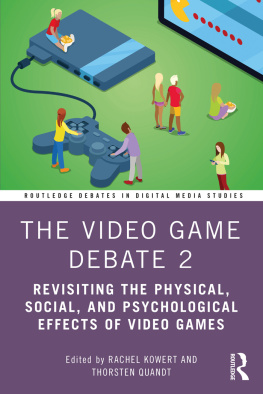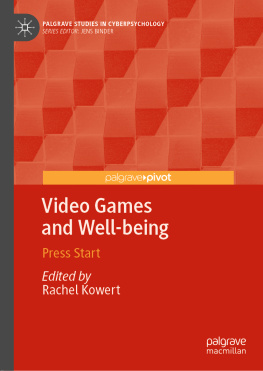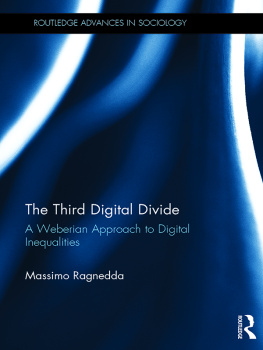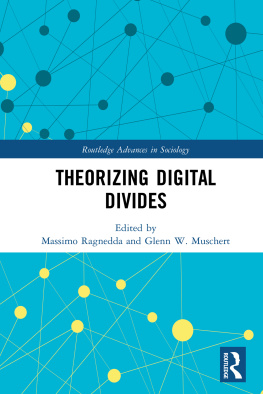
New Perspectives on the Social Aspects of Digital Gaming
This is a timely addition to Game Studies, especially in the way it addresses issues at the heart of gaming communities at present. A strong body of complimentary chapters produce a well-rounded picture of gaming communities and the issues they face.
Esther MacCallum-Stewart, University of the West of England, UK
As with the previous volume, this book brings together an interesting and enlightening sampler of the latest original research on social aspects of digital games from talented new scholars and established leaders in the field. An excellent survey on where research on digital games is going, and where it should go.
James D. Ivory, Virginia Tech, USA
Expanding on the work in the volume Multiplayer, this new book explores several other areas related to social gaming in detail. The aim is to go beyond a typical edited book concept, and offer a very concise volume with several focal points that are most relevant for the current debate about multiplayer games, both in academia and society. As a result, the volume offers the latest research findings on online gaming, social forms of gaming, identification, gender issues and games for change, primarily applying a social-scientific approach.
Rachel Kowert recently completed a Postdoctoral Fellowship at the University of Mnster, Germany.
Thorsten Quandt holds the chair of Online Communication at the University of Mnster, Germany.
Routledge Advances in Game Studies
1 Video Games and Social Competence
Rachel Kowert
2 Sexuality in Role-Playing Games
Ashley ML Brown
3 Gender, Age, and Digital Games in the Domestic Context
Alison Harvey
4 The Dark Side of Game Play
Controversial Issues in Playful Environments
Edited by Torill Elvira Mortensen, Jonas Linderoth, and Ashley ML Brown
5 Understanding Counterplay in Video Games
Alan F. Meades
6 Video Game Policy
Production, Distribution, and Consumption
Edited by Steven Conway and Jennifer deWinter
7 Digital Games as History
How Videogames Represent the Past and Offer Access to Historical Practice
Adam Chapman
8 New Perspectives on the Social Aspects of Digital Gaming
Multiplayer 2
Edited by Rachel Kowert and Thorsten Quandt
First published 2017
by Routledge
711 Third Avenue, New York, NY 10017
and by Routledge
2 Park Square, Milton Park, Abingdon, Oxon OX14 4RN
Routledge is an imprint of the Taylor & Francis Group, an informa business
2017 Taylor & Francis
The right of the editors to be identified as the authors of the editorial material, and of the authors for their individual chapters, has been asserted in accordance with sections 77 and 78 of the Copyright, Designs and Patents Act 1988.
All rights reserved. No part of this book may be reprinted or reproduced or utilised in any form or by any electronic, mechanical, or other means, now known or hereafter invented, including photocopying and recording, or in any information storage or retrieval system, without permission in writing from the publishers.
Trademark notice: Product or corporate names may be trademarks or registered trademarks, and are used only for identification and explanation without intent to infringe.
Library of Congress Cataloging-in-Publication Data
CIP data has been applied for.
ISBN: 978-1-138-64363-5 (hbk)
ISBN: 978-1-315-62930-8 (ebk)
Typeset in Sabon
by codeMantra
Thorsten Quandt and Rachel Kowert
When the first Multiplayer volume was published some years ago, it was primarily looking at the social aspects of digital gaming with a strong focus on online (computer) games, virtual worlds, and, to some extent, console games. The core message of the book was a very simple one and beyond the depth and variation of the individual articles: Modern gaming is mostly a social form of mainstream media entertainment. In that sense, the book elucidated that the stereotypical image of the solitary, reclusive, and socially inept gaming geek in popular culture often equated with exaggerated and condescending depictions of pubescent, male nerds was just echoing a radically reduced caricature of computer gamers from earlier phases in the evolution of gaming.
The evolution of gaming has not stopped. In fact, even in the few years since the first Multiplayer volume, there have been many crucial developments and changes in the industry. For example, there has been a differentiation of distribution channels, with a decline in boxed products and a rise in online distribution. Mobile gaming on smartphones has also become a dynamic market, social (network) games have been on the rise (and the decline again), and virtual reality head-mounted displays have come to be touted as the next big thing to revolutionise (not only) gaming. These are just a few of the notable developments in a very short time, and, as editors, we felt that a new Multiplayer book was necessary to fill some of the research gaps that were becoming all too obvious with the many innovations in the field.
The current book is not meant to replace the older one, but rather should be seen as complementary to the previous one, by adding new and innovative aspects. It can be argued that any edited volume in such a dynamic environment will always remain incomplete, especially when relying on concrete and current research. Technological developments and social changes will lead to new phenomena that were unknown at the time of writing. And these are not only peripheral fluctuation in the material objects of analysis, but changes to the very essence of the phenomenon per se. So gaming itself does not remain the same!
The evolutionary metaphor (despite some obvious limitations) may be a helpful for a moment, in understanding this statement better: Gaming, as a social phenomenon, can be regarded as being coevolving with society and its communication and media technologies. Even the use of basic technologies that may look like static devices at first sight (a console, a computer, a smartphone, etc.) becomes embedded and shaped in our social environments until they are superseded by new generations of superior devices with improved capabilities and functions. With the software side, the evolutionary character is probably even more obvious games are updated and patched, extended with download content, adapted to new situations and demands, socially embedded in day-to-day practices, and sometimes even used in ways beyond the imagination of the developers and designers. And when regarding gaming as a social collectivity, its evolutionary character, with ongoing changes and differentiation, is more than apparent and again, this sequel of Multiplayer is a reaction to this.
For us as scientific observers, the fast differentiation of the field poses many problems, though. As noted previously, our work always remains incomplete, and often we are even slower than the developments in the field. Studies need to be prepared, ethically approved, and conducted, often with limited resources. Analyses need considerable time as well, and the writing and publishing process delays the public circulation of innovative scientific findings considerably (and to be frank, editors sometimes also delay the process by imposing stressful rewriting procedures on their esteemed authors!). As a result, and probably also in principle, our work is just a snapshot of a social reality that has already evolved in a different direction. When reading older texts on gaming and gamer culture, we are often surprised how ancient these descriptions read sometimes like ethnographic depictions of exotic tribes from colonial times. Without any doubt, much of the excellent work in this book will probably make a similar impression to future generations of games researchers.












